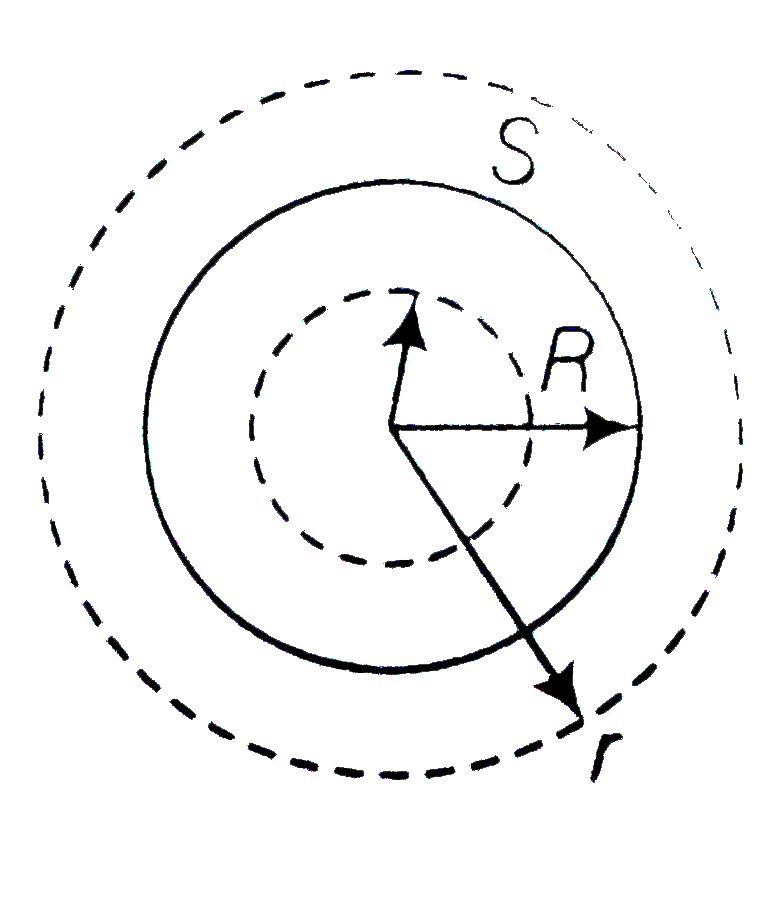Consider a sphere of radius R with charge density distributed as ρ(R)=kr for r≤R,ρ(R)=0 for r>R.
(a) Find the electric field at all points r.
(b) suppose the total charge on the sphere is 2e, where e is the electron charge. Where can two protons be embedded such that the force on each of them is zero. Assume that the introduction of the proton does not alter the negative charge distribution.


(a) Let us consider a sphere S of radius R and two hypothetic sphere of radius r<Randr>R
Now, for point rltR, electric field intenstiy will be given by:
∮E.dS=1ε0∫ρdV
[For dV, V=43πr3⇒dV=3×43πr3dr=4πr2dr]
⇒∮E.dS=1ε0)4πK∫r0r3dr (∵p(r)=Kr)
⇒(E)4πr2=4πKε0r44
⇒E=1ε0Kr2
here, charge density of positive.
So, direction of E is radially outwards.
For points r>R, electric field intenstiy will be given by
∮E.dS=1ε0∫ρ.dV
⇒E(4πr2)=4πKε0∫R0r3dr=4πKε0R44
⇒E=K4ε0R4r2
Charge density is again positive. So, the directio of E is radially outward.
(b). The two protons must be on the opposite sides of the centre along a diameter folloiwng the rule of symmetry. this can be shown by the figure given below. cahrge on the sphere.

q=∫R0ρdV=∫R0(Kr)4πr2dr
q=4πKR44=2e
∴K=2eπR4
If protons 1 and 2 are embedded at distance r from the centre of the sphere as shown, the attractive force on proton 1 due to charge distribution is
F1=eE=−eKr24ε0
Repulsive force on proton 1 due to proton 2 is
F2=e24πε0(2r)2 ltBrgt Net force on proton 1,
F=F1+F2
=F=−eKr24ε0+e216πε0r2
so, F=[−er24ε0Ze4πR4+e216πε0r4]
Thus, net force on proton 1 will be zero, when
er22e4ε0πR4=e216πε0r
⇒r4=R48
⇒r=R(8)1/4 ltBrgt This is the distance of each of the two protons from the centre of the sphere.
Topper's Solved these Questions
Similar Questions
Consider a sphere of radius R with charge density distributed as ρ(R)=kr for r≤Rand=0 for r>R.
(a) Find the electric field at all points r.
(b) suppose the total charge on the sphere is 2e, where e is the electron charge. Where can two protons be embedded such that the force on each of them is zero. Assume that the introduction of the proton does not alter the negative charge distribution.

View SolutionA sphere of radius R contains charge density ρ(r)=A(R−r), for 0<r<R. The total electric charge inside the sphere is Q.
The electric field inside the sphere is
View Solution
Knowledge Check
Let ρ(r)=QrπR4 be the charge density distribution for a solid sphere of radius R and total charge Q. For a point P inside the sphere at a distance r1 from the centre of the sphere, the magnitude of electric field is
AQr214πε0R4BQr213πε0R4C0DQ4iε0r21Let ρ(r)=QrπR4 be the charge density distribution for a soild sphere of radius R and total charge Q. For a point P inside the sphere at a distance r1 from the centre of the sphere, the magnitude of electric field is
AQ4πε0r21BQr214πε0R4CQr213πε0R4DzeroA conducting sphere of radius R is charged to a potential of V volts. Then the electric field at a distance r(>R) from the centre of the sphere would be
ARVr2BVRCrVR2DR2Vr2
A solid ball of radius R has a charge density ρ given by ρ=ρ0(1−rR)for0≤r≤R The electric field outside the ball is :
View SolutionConsider a spherical symmetric charge distribution with charge density varying as ρ={[ρ0(1−rR),r≤R][0,,r>R]}The electric field at r ,r≤R will be
View SolutionA sphere of radius R contains charge density ρ(r)=A(R−r), for 0<r<R. The total electric charge inside the sphere is Q.
The value of A in terms of Q and R is
View SolutionA sphere of radius R_(0 carries a volume charge density proportional to the distance (x) from the origin, rho=alpha x where alpha is a positive constant.The total charge in the sphere of radius R_(0) is
View SolutionA charge +Q, is uniformaly distributed within a sphere of radius R. Find the electric field, due to this charge distribution, at a point distant r form the centre of the spehre where :
(i) 0<r<R and
(ii)r>R
View Solution

